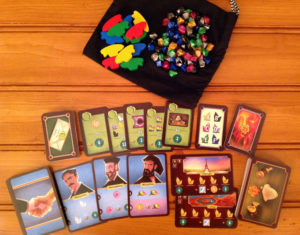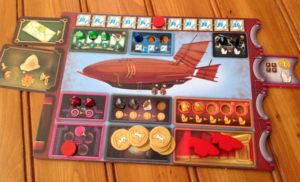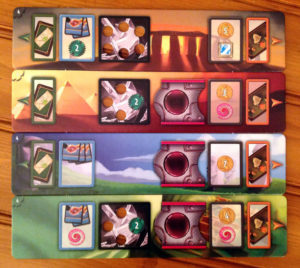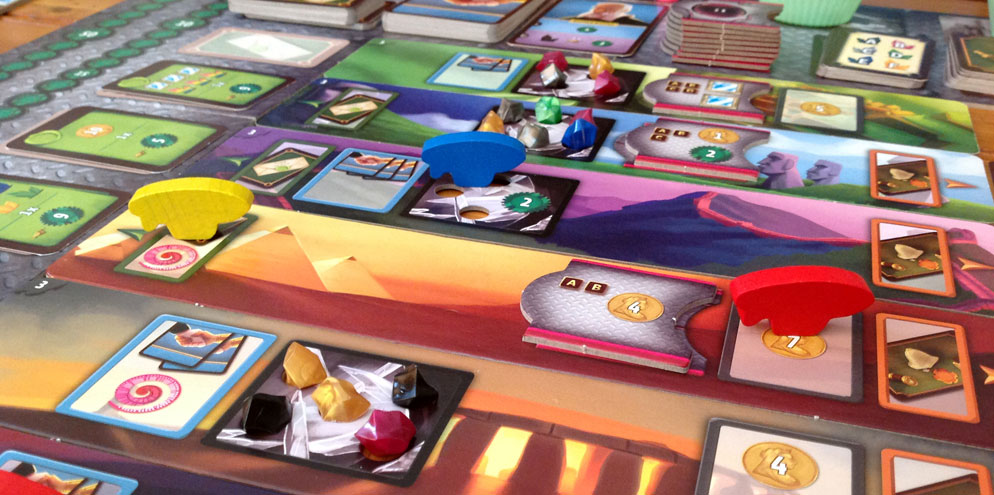 Istanbul is a game by designer Rüdiger Dorn which I have previously reviewed for Board Game Quest. It won the “Kennerspiel des Jahres” award for 2014, and I gave the game 5 stars for its simplicity in learning, its wealth of choices players are presented with and its artwork and components.
Istanbul is a game by designer Rüdiger Dorn which I have previously reviewed for Board Game Quest. It won the “Kennerspiel des Jahres” award for 2014, and I gave the game 5 stars for its simplicity in learning, its wealth of choices players are presented with and its artwork and components.
In early 2016, KOSMOS released Mr. Dorn’s latest offering, Steam Time. Since I enjoyed Istanbul so much, I had no trouble adding Steam Time to my “must try” list. The theme this time (somewhat pasted on, but that’s ok) puts players in the role of time-traveling agents attempting to gain knowledge, resources and treasures from various eras throughout time and space. The game mechanics used to do this seem to be right in Mr. Dorn’s wheelhouse. Do these mechanics make for another game worthy of adding to your collection? Let’s jump into our airships and find out!
Steam Time is a worker placement/resource management game, designed by Rüdiger Dorn. It supports 2 to 4 players and plays in about 90 minutes.
Game Overview:
In Steam Time, players are agents of the “Temporal Institute for Monument Exploration” (or “T.I.M.E.” for short) and will use their steam-powered airships to travel through the time stream into different eras, taking 3 actions per round to collect knowledge, resources, money and treasures from famous monuments, which can all earn them esteem within the agency. After 5 rounds, the agent with the highest esteem (victory points) is the winner.
Game Components:

There are lots of cool, colorful bits in this game. Most striking of all are the main game board, the monument boards which show the available actions in each era and the player boards which depict the player’s airship and its various generators.
Each generator is associated with an action on the game board, and is powered by a different colored crystal. The crystals are nicely shaped plastic “gems” in 6 colors, with additional clear crystals representing “T.I.M.E.” (wild) crystals. There are multiple sets of cards relating to the various actions, a supply of gold coins, some cardboard upgrade tiles and wooden pieces for the players; most notable are the airship-shaped pieces with which the players select their actions on the game board. There are also some extra cards and tokens for two advanced modules.
How to Play:
Six player number-specific monument boards are randomly laid out in a column, within the main game board framework. This represents the “time stream”, an important concept once players begin taking actions. The components for each action (explained below) are added to the board where specified.
Each player takes a player board and all components in that color. The start player takes the first player tile (showing 2 special actions), and the game can begin.
On a player’s turn, they can either take the first player tile or place one of their airships on an unoccupied space on the game board and take its action. Taking the first player tile will (naturally) allow that player to be the first player in the next round. It also allows that player to take one of the two special actions shown on it (converting steam in their airship to either esteem or T.I.M.E. crystals).
Before describing the 6 available actions, it’s important to note some rules about the generators on a player’s airship board. Throughout the game, players will (hopefully) be acquiring different crystals. When receiving them, they must be placed in the corresponding generator, from left to right. The clear T.I.M.E. crystals are “wild” and can be used in any generator.

When a player is taking his first action in a round, he may place his airship on any unoccupied action space. However, on subsequent turns, he must “follow the time stream”, which means that his airship must be placed at least 1 monument board further up in the time stream. None of the individual monument boards show all 6 actions, which can make action selection tricky. Depending on the action taken, the player will also receive some type of bonus based on the number of crystals they have in the corresponding generator at that time. From left to right across the game board, a player can take the following actions:
- Mission (Green): The player takes a face-down mission card adjacent to the action space, and keeps it next to his airship board. The mission cards can earn the player end game esteem points. The majority of a player’s points are earned with mission cards. The green generator bonus lets the player earn extra esteem points.
- Encounter (Blue): The player draws either 2 or 3 encounter cards, and chooses one of them to play. The encounter cards come in two styles: ones that give a player a choice of two rewards to receive, or ones that let the player receive a slightly larger reward, at the expense of giving the other players a possible conversion reward as well. The blue generator bonus lets the player move their steam marker up the track.
- Crystal Deposit (Black): Each crystal deposit space on the monument boards contains various crystals drawn at random from the bag. By taking this action, the player may purchase any number of these crystals for 2gold each. The black generator bonus gives the player clear T.I.M.E. crystals.
- Upgrade (Pink): The player purchases the upgrade tile from the action space and attaches the upgrade to their airship board. Having upgrade tiles awards the player various income (gold coins, esteem points, crystals) at the beginning of each subsequent round. The pink generator bonus lets the player move their time portal marker clockwise. When the marker has made a complete revolution of 5 spaces on the time portal track, they can immediately take an extra bonus action (without using one of their airships).
- Gold (Gray): The player takes gold as specified on the action space. The gray generator bonus gives the player additional gold.
- Expedition (Orange): The player purchases the expedition card at the action space (again, using the current round’s “effort” card to determine the cost in crystals). For this action, the orange generator bonus is associated with the expedition card taken, and gives the player various rewards depending on the number of orange crystals currently in the generator.
When no player can or wants to take any additional actions, and the first player tile has been claimed, the round ends. Everything is reset for the next round, including shifting the positions of the monument boards, restocking the cards, crystals and upgrade tiles on them.
The game ends after 5 rounds. Final scoring consists of players revealing their mission cards collected during the game, and fulfilling those that they can by turning in the requested resources. The player with the most esteem (victory points) is the winner.

Game Experience:
I like having lots of choices in a game. Put a bunch of possible actions in front of me on my turn, and I’m pretty happy. On every turn in Steam Time, there is no shortage of things you can do. The trick, of course, is knowing whether the thing you are doing on a turn is the best option.
Since the mission cards seem to be where the bulk of a player’s points are earned, the most logical strategy to take is to collect as many of them as you can. This allows you to give yourself plenty of options on which ones and how many you can complete. Collecting all the necessary resources isn’t as easy as it sounds. Even though all of the actions are designed to provide resources, getting the ones you want, when you want them, can be tricky.

The “time stream” concept, which limits the actions a player can take, is a simple, yet clever one. There are going to be many times when the sweetest action is high up on the board, but if you take it too early, you will be severely limiting the remaining actions you can take for the rest of the round. Do you jump high on the board early in the round to grab that action before another player does, or do you play it safe, starting low on the board and gradually moving up, so you don’t get stuck not being able to take any actions at all? This is that sweet frustration that shows up in the best board games of this type.
There are 2 “advanced” modules that can be added to the game; one that limits action spaces even further, and one that gives each player a small set of cards with rule-breaking powers on them. They are both fine, but I wouldn’t say that either of them is necessary; the base game is fine as is.
Components-wise, this is one good-looking game. As mentioned earlier, everything is bright and colorful, and yet all that color isn’t distracting at all. Each time I had this game on the table at my gaming club, people walking past would always stop and comment on the look of it. The artwork is very appropriate to the theme, and the icons used in the game are pretty intuitive to understand, for the most part. To one who has struggled with confusing icons in so many euro games, this is a welcome thing.

Speaking of theme, this is one area where the game probably falters a little bit. Don’t get me wrong, I have played plenty of games that are much “drier” than Steam Time. But the whole idea of time traveling agents, while sounding cool, doesn’t actually define the game, or make it any more (or less) interesting. Just about any theme would have worked here, since players are essentially placing workers and gaining resources. Hey, at least we aren’t traders in renaissance Europe…
The only other nit I would have to pick would be with the rule book. I’m a stickler for a clearly written rule book – who wouldn’t be, really? However, this one could have benefited from some better organization. In a few of my games, we had some minor rules questions arise, and we had a really hard time finding the answer in the rule book. One of the questions had to do with when, and how often, a player receives income from their upgrade tiles. We played almost the entire game wrong, before finding the answer in one little inconspicuous sentence, which probably should have been called out in a bigger or bolder typeface. Part of playing board games is going through the process of learning them, but rule books should make learning easier, not more difficult.
Those minor points aside, however, I still found Steam Time to be a pretty enjoyable game.
Final Thoughts:

Well, it looks like Mr. Dorn has done it again. Just as with Istanbul, Steam Time gives players a variety of actions they can do on their turn, and lets them figure out how and when to do them, in order to manage their resources in the best possible way. The concept of only moving one way up the “time stream” when choosing actions is a clever one, as is the set of encounter cards that give you resources… as long as you are willing to let the other players receive something as well.
There’s nothing else really groundbreaking here in this “place a worker, get some resources, turn in a certain set of those resources for points” game, but I don’t think there always needs to be in order to enjoy it. Steam Time is easy to learn, and I think it works well with both casual and more hardcore gamers. This one is staying in my collection.
If you’d like to pick up a copy of Steam Time, you can get it for about $45.
Final Score: 3.5 Stars – A solid worker placement game that’s not breaking tons of new ground, yet still provides an enjoyable experience.
 Hits:
Hits:
• Bright, colorful board and game pieces
• Easy to learn with logical icons, the game phases become intuitive by the second round.
• Gives players that “good” frustration feeling because of all the choices available every turn.
Misses:
• Theme is not exactly the strongest.
• The rule book could use a little reorganization for better reading.






















